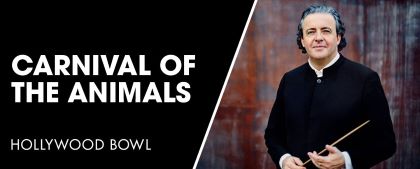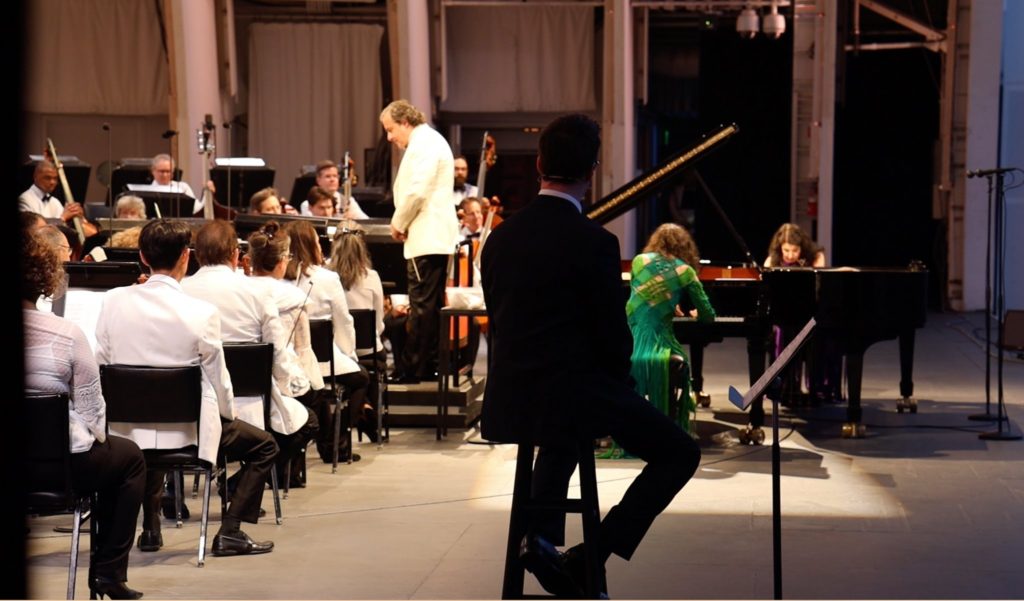BEAUTY AND HUMOR
I wonder what French Romantic composer Camille Saint-Saëns (1835-1921) would have thought had he known his Carnival of the Animals (Le Carnaval des Animaux) would become one of his most well-known and perhaps best-loved works. Written in 1886, it was meant to be a divertissement for his pupils to play, so the 25-minute cycle contains fourteen short to very short movements — all of which are interpretations of assorted creatures.
Originally scored for two pianos and small ensemble (including a glass harmonica*), there are several arrangements (including one for just two pianos), but only one part was allowed by the composer to be published in his lifetime: The Swan, the penultimate piece, with its famous haunting cello solo. (Saint-Saëns was reticent to publish more as he felt these expressive and often humorous miniatures would make him seem less of a serious composer.)
Utilizing the expressive piano duo, sisters Katia and Marielle Labèque, and humorous actor Sean Hayes, LA Phil’s Hollywood Bowl 2019 opening was an enchanting hoot. I was already looking forward to seeing the French pianists, having recently heard their astoundingly accessible (given some new music) CD of El Chan, which has the ladies absolutely nailing American composer Bryce Dessner’s Concerto For Two Pianos.
But Sean Hayes? you may ask. From TV’s sitcom Will & Grace? I was surprised and bemused when I saw his name inserted in the program with a note: “Text by Sean Hayes.” And, frankly, I also had a sinking feeling that his presence would mar the gravitas of the event. But boy oh boy did he ever prove me wrong. Carried out in a cage, he emerged in a suit and offered an old-fashioned Bob Hope-kind of routine, making witty remarks in-between pieces and even getting involved with Marielle for Movement 10, “Pianistes,” which depicts pianists diligently working at their scales (yep, Hayes is a classical pianist) — he also took conductor Juanjo Mena’s baton for three chords. Inhabiting his cute, conceited character of W&G‘s Jack McFarland, Hayes wasn’t afraid of racy humor, referring to “Poules et coqs” (“Hens and Roosters”) and “Hémiones (animaux véloces)” (“Wild Donkeys [Fleet Animals]”) as establishments in West Hollywood with “Hens and Cocks” and, down the street, “Wild Asses.”
The sound balance between the pianos and the orchestra was impeccable, so we could hear every tinkling note of the haunting “Aquarium” and “Le Coucou au fond des bois” (The Cuckoo in the Depths of the Forests), which has the pianos play complex, light chords while Boris Allakhverdyan’s clarinet plays a single two-note ostinato mimicking the call of a cuckoo bird. I couldn’t espy Allakhverdyan, so I wonder if he was offstage as Saint-Saëns states in the original score. Also great: the Psycho-sounding “Personnages à longues oreilles” (“People with Long Ears,”), thought to be directed at music critics, who are also supposedly the last animals heard during the can-can-like finale, braying; the thick, lumbering double basses in “L’Éléphant” (“The Elephant”); Robert deMaine’s bittersweet cello in “The Swan”; and, especially, Denis Bouriakov’s amazing flute solo in “Volière” (“Aviary”), nailing a trilling tune that spans much of the flute’s range.
The video below has a few clips from the show, but also gives you an insight as to how many people are responsible for making these shows go as smoothly as they do at the Bowl.
https://www.facebook.com/SeanHayes/videos/vb.235697306486594/461063564471463/?type=2&theater
—————————————————————————–
Originally called Episode in the Life of an Artist, the second-half of our program is better know today by its subtitle Symphonie fantastique. A program symphony with a narrative inspired by Berlioz’s love of an Irish actress, it was unlike anything that had been written before. It tells the story of “an artist gifted with a lively imagination” who has “poisoned himself with opium” in the “depths of despair” because of “hopeless love” (while it hasn’t been substantiated, some believe Berlioz was high on opium while composing). It’s five movements are a ferment of ideas, emotions and Gothic imagery connected by a recurring but varied theme, the idée fixe, representing the obsessive love that permeates the piece. And with Mena’s chameleonic countenance, this astonishing work was made even stronger than I’ve heard before — animated, brisk, and spirited at times, especially with that full brass ensemble — yet soft, foreboding, and mysterious at others. Most mind-bending is that the 1830 work contains a staggering series of inventions.
Berlioz was a master of orchestration, and, as always, LA Phil’s players boasted astounding individuality and sheer glory of sound: Camille Wells’s floating oboe solo in “Reveries and Passions”; the heavenly accentuated plucks of harpists Maria Casale and Jacqueline Marshall, and the smooth animated clarinets of Mr. Allakhverdyan and Andrew Lowy in “A Ball”; Carolyn Hove’s mellow but firmly supported cor anglais (or English horn, an instrument unknown in previous symphonies) in “Scene in the Country”; and bassoonist Whitney Crockett’s immaculate breathing techniques in “Scaffold,” which also highlighted the blood-pounding booms of Matthew Howard, James Babor, and Eduardo Meneses (percussionists) and Joseph Pereira and Jeff Grant (timpani).
It seemed relatively quiet at the Bowl for this programmatically perfect evening, yet a little birdie told me that over 10,000 tickets were sold. It’s such an iconic way to enjoy our city at night, that even more simply must attend. I wonder how many folks know that there are tickets as low as eight bucks for most classical nights; it really is the best deal in town.
* Benjamin Franklin’s invention, the “glass armonica,” consisted of a mounted series of shallow, concentrically positioned cast lead glass bowls onto a horizontally spinning shaft that was continuously spun by a handy foot treadle. The bowls graduated in size with each glass replicating a single tone. Since the glass harmonica was arrayed like a keyboard instrument, you could play up to ten notes at one time. Equally inventive was that the spinning bowls continually picked up moisture from a water-filled reservoir beneath them as they spun; forget about having to moisten fingertips.
video and photo from Sean Hayes’s Facebook Page
Los Angeles Philharmonic
Juanjo Mena, conductor
SAINT-SAENS: Carnival of the Animals
BERLIOZ: Symphonie fantastique
Hollywood Bowl
played July 9, 2019
for future tickets, call 323.850.2000 or visit LA Phil


